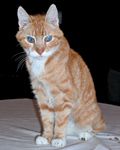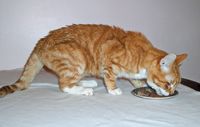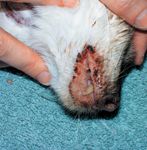Feline hyperthyroidism
Hyperthyroidism can be diagnosed in most cats based on clinical signs consistent with the disease, physical examination findings including a palpable thyroid nodule and an increased serum total T4 concentration.
Hyperthyroidism can be diagnosed in most cats based on clinical signs consistent with the disease, physical examination findings including a palpable thyroid nodule and an increased serum total T4 concentration.

Treatment options for hyperthyroid cats are short- or long-term use of orally or topically administered antithyroid drugs, radioactive iodine 131 (131I) or surgical thyroidectomy.
Routine laboratory evaluation including a complete blood count, serum chemistry profile, urinalysis and serum T4 concentration are valuable in diagnosing hyperthyroidism and help to identify concurrent diseases.
Most hyperthyroid cats show mild to moderate increases of serum alanine aminotransferase or serum alkaline phosphatase activities. Measurement of random serum T4 concentrations has been reliable in identifying cats with hyperthyroidism. Fluctuation of serum thyroid hormone concentrations and suppression of increased thyroid hormone concentrations resulting from concurrent non-thyroidal disorder may explain why some cats with suspected hyperthyroidism have a serum T4 concentration within the reference interval. Therefore, the diagnosis of hyperthyroidism should not be ruled out on the basis of one serum T4 concentration within the reference interval, especially if the cat has clinical signs and a palpable thyroid nodule.
Recommendation is to measure serum T4 concentration days to weeks after the initial result was obtained and to rule out non-thyroidal illness.
If the serum T4 concentration remains non-diagnostic and hyperthyroidism is still suspected, thyroid function should be reassessed after resolution of non-thyroidal illness, a serum-free T4 concentration may be assayed, a thyroid scan may be obtained, and lastly, a T3 suppression test or thyrotropin-releasing hormone stimulation test may be done.
The goal of therapy is to control or inhibit excessive secretion of thyroid hormones. Treatment options include short- or long-term use of orally or topically administered antithyroid drugs, radioactive iodine 131 (131I) or surgical thyroidectomy. Each form of therapy has advantages and disadvantages that must be considered and are summarized in Table 1.

Table 1: Advantages and disadvantages of the three major forms of therapy for feline hyperthyroidism*
Medical therapy is a reversible form of treatment, whereas surgery and administration of 131I are permanent. Trial transient therapy with methimazole (oral or topical) should be done prior to use of a permanent treatment method.
Methimazole inhibits several steps in thyroid hormone synthesis and is very effective in restoring euthyroidism in most cats. Methimazole does not inhibit the peripheral conversion of T4 to T3 and has no effect on thyroid hormones already formed or present in circulation.
Methimazole is considered the antithyroid drug of choice for test treatment to normalize serum T4 concentration to assess the effect of resolving hyperthyroidism on renal function. If renal function improves or remains static, a more permanent therapeutic option, including surgical thyroidectomy or 131I, may be chosen. Methimazole should be used as a short-term therapeutic management of hyperthyroidism to prepare a cat for surgery or the prolonged hospitalization associated with 131I. Finally, methimazole can be used as long-term management of hyperthyroidism.

Hyperthyroidism is a common endocrinopathy in older cats. Cats may present with clinical signs including polyphagia, weight loss, polyuria and polydypsia.
Methimazole may cause various adverse reactions, which are less common when conservative dose protocols as described below are used. Common mild side effects (unrelated to the dose of methimazole used) include anorexia, vomiting and lethargy. These signs are usually transient and commonly resolve despite continued administration of methimazole. If any side effect is noted, methimazole should be discontinued, at least temporarily. Methimazole can be reinstituted at a lower dose if these side effects resolve or an alternative therapy may be chosen. Self-induced facial excoriation may occur within the first four to eight weeks of therapy. Methimazole should be discontinued, and an alternative therapy should be considered. Hepatotoxicity is another serious side effect of methimazole and is characterized by increased activities of serum alanine aminotransferase and alkaline phosphatase, total bilirubin, and is usually associated with lethargy, anorexia and vomiting. Methimazole should be discontinued; supportive care should be instituted, and an alternative therapy should be considered. Methimazole may induce serious hematologic changes, such as thrombocytopenia, agranulocytosis, immune-mediated hemolytic anemia, positive antinuclear antibody test results and coagulopathy. Methimazole should be discontinued, and an alternative therapy should be considered. Myasthenia gravis was reported in four cats after treatment with methimazole.

Facial excoriation in a hyperthyroid cat treated with methimazole.
Oral methimazole: treatment and monitoring
Considering that methimazole may cause hematologic and biochemical side effects, it is recommended to obtain a baseline CBC, serum chemistry profile and urinalysis prior to initiate therapy. Recommended initial dose of methimazole is 2.5 mg twice a day for two weeks. When concerns about side effects warrant a more conservative approach (e.g., azotemic cat), cats can be started on 2.5 mg once a day or 1.25 mg twice a day. Following these two weeks, the cat should be re-evaluated, and a CBC, serum chemistry profile, and serum T4 concentration should be submitted. If the serum T4 concentration is below the reference interval, the dose should be reduced by 2.5 to 5 mg/day. If development of agranulo-cytosis, anemia, thrombocytopenia or hepatopathy is noted, methimazole should be discontinued, and an alternative therapeutic option must be sought for these cats. If azotemia is noted, methimazole should be discontinued, or the dose should be reduced. If serum T4 concentration is low to normal and the cat is not azotemic, methimazole can be continued or a permanent therapeutic option (i.e., surgical thyroidectomy, 131I) may be chosen. If the hyperthyroidism is not controlled, the dosage should be increased every two weeks in increments of 2.5 mg a day. Most cats require 5 or 7.5 mg/day of methimazole to control hyperthyroidism. Methimazole is most effective given every 12 hours compared with once-daily administration. If doses of 10 mg/day or more do not reduce serum T4 concentrations, veterinarians must evaluate owner compliance by watching the owner administer a pill to their cat. After three months of close monitoring (history, physical exam, CBC, serum chemistry profile, serum T4 concentration every two to three weeks), re-evaluation should be done every three to six months.
Topical methimazole
With new compounding methodology, methimazole can be administered topically. However, the final product varies from one compounding pharmacy to another. The owner must wear gloves during application into the pinna of the ear, should alternate ears, and wipe away any residual gel after each administration. There is no difference in hematologic side effects, facial excoriation and hepatotoxicity. Less gastrointestinal side effects occur with transdermal methimazole. Local crusting and erythema may be noted, although these side effects rarely prevent continuing use.

References
How to approach therapy of a cat with concurrent hyperthyroidism and renal disease?
Hyperthyroidism can increase the glomerular filtration rate (GFR) and decrease the serum creatinine and BUN concentrations, masking underlying renal disease. In addition, the reduction in muscle mass associated with hyperthyroidism may contribute to the reduction of serum creatinine concentrations, which may further mask any underlying renal disease. Renal disease, a nonthyroidal illness, may lower serum T4 concentrations and mask hyperthyroidism. It could be argued that reducing the serum T4 concentrations in a cat with these concurrent diseases should be avoided because such treatment may reduce the GFR and cause azotemia. On the other hand, if an increased GFR results in glomerular hyperfiltration in hyperthyroid cats, it may contribute to progression of renal disease, and early treatment may be important to prevent renal changes. The dose of methimazole can be adjusted to achieve the best possible control of hyperthyroidism and maintain adequate renal function. The recommended initial dose of methimazole for cats with hyperthyroidism and concurrent renal disease is 2.5 mg once a day or 1.25 mg twice a day for two weeks. A re-evaluation is then completed as described above (CBC, serum chemistry profile, serum T4 concentration). If serum T4 concentration is normal or decreased toward normal and serum creatinine, phosphorus and BUN improve, methimazole can be continued. If renal parameters worsen with improved serum T4 concentration, methimazole should be discontinued. Renal parameters should be monitored, and methimazole dose may be reduced, the goal being to minimize the clinical signs of hyperthyroidism without worsening renal disease.
By using a more conservative methimazole dose protocol, clinical improvement may be noted two to six weeks after control of serum T4 concentration has been achieved. The owners should be aware of this delay so that they understand what to expect.
Podcast CE: A Surgeon’s Perspective on Current Trends for the Management of Osteoarthritis, Part 1
May 17th 2024David L. Dycus, DVM, MS, CCRP, DACVS joins Adam Christman, DVM, MBA, to discuss a proactive approach to the diagnosis of osteoarthritis and the best tools for general practice.
Listen